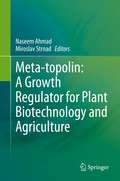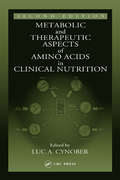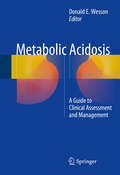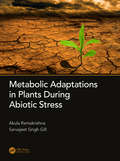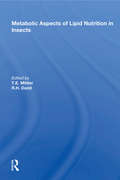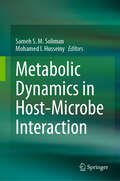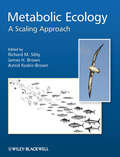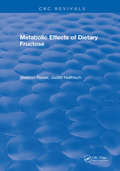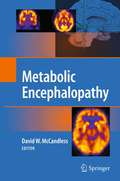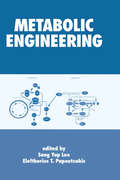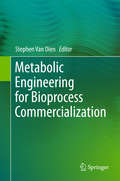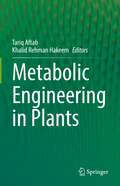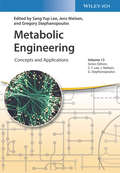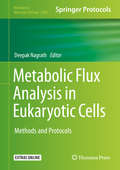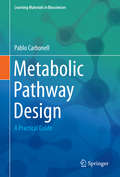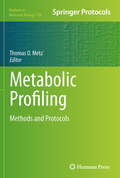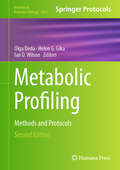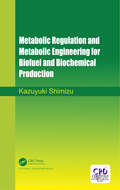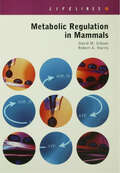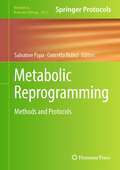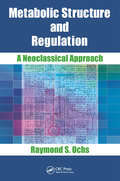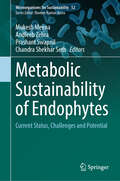- Table View
- List View
Meta-topolin: A Growth Regulator for Plant Biotechnology and Agriculture
by Naseem Ahmad Miroslav StrnadPlant tissue culture (PTC) technology has gained unassailable success for its various commercial and research applications in plant sciences. Plant growth regulators (PGRs) are an essential part of any plant tissue culture intervention for propagation or modification of plants. A wide range of PGRs are available, including aromatic compounds that show cytokinin activities, promote cell division and micro-propagation, viz. kinetin, N6-benzyladenine and topolins. Topolins are naturally occurring aromatic compounds that have gained popularity as an effective alternative for other frequently used cytokinins in in vitro culture of plants. Among them, meta-topolin [6-(3-hydroxybenzlyamino) purine] is the most popular and its use in plant tissue culture has amplified swiftly. During the last few decades, there have been numerous reports highlighting the effectiveness of meta-topolin in micropropagation and alleviation of various physiological disorders, rooting and acclimatization of tissue culture raised plants.
Metabolic & Therapeutic Aspects of Amino Acids in Clinical Nutrition
by Luc A. CynoberThe first edition of this innovative book brought a new perspective to the metabolic and therapeutic aspects of amino acids in clinical nutrition. Since its publication, a number of very important advances have been made in the field and interesting new findings have emerged. Until now, no reference has fully explored the promising new developments
Metabolic Acidosis
by Donald E. WessonThis timely volume provides an overview to the causes, effects on systems and clinical approaches of metabolic acidosis. Beginning with a basic understanding of the physiology, pathophysiology and development of this disease, subsequent chapters cover the characteristics and context of the processes that can cause it and a thorough presentation of management strategies. Recommended treatments include those carried out by the health care provider as well as the individual patient, such as dietary management. Clinicians and healthcare professionals will find the tools needed to recognize, work up and manage patients with metabolic acidosis in this practical and concise resource.
Metabolic Adaptations in Plants During Abiotic Stress
by Sarvajeet Singh Gill Akula RamakrishnaKey features: Serves as a cutting-edge resource for researchers and students who are studying plant abiotic stress tolerance and crop improvement through metabolic adaptations Presents the latest trends and developments in the field of metabolic engineering and abiotic stress tolerance Addresses the adaptation of plants to climatic changes Gives special attention to emerging topics such as the role of secondary metabolites, small RNA mediated regulation and signaling molecule responses to stresses Provides extensive references that serve as entry points for further research Metabolic Adaptations in Plants during Abiotic Stress covers a topic of past, present and future interest for both scientists and policy makers as the global challenge of climate change is addressed. Understanding the mechanisms of plant adaptation to environmental stresses can provide the necessary tools needed to take action to protect them, and hence ourselves. This book brings together recent findings about metabolic adaptations during abiotic stress and in diverse areas of plant adaptation. It covers not only the published results, but also introduces new concepts and findings to offer original views on the perspectives and challenges in this field.
Metabolic Aspects Of Lipid Nutrition In Insects
by T. E. Mittler R. H. DaddOur understanding of the physiological function of insect essential lipids has long been flawed by major uncertainties. It was discovered long ago that dietary sterol is a necessary nutrient for all insects, which radically sets them apart from the vertebrates in terms of qualitative nutrient requirements. Because of the physiological importance of sterol as a molting hormone precursor in insects and the implications of this for the development of new insecticides, a wealth of investigation into insect sterol metabolism followed, covering both the ways in which insects convert diverse food-plant sterols into the major tissue sterols and how these in turn are metabolized into the ecdysone molting hormones. However, for the classes or essential Lipid nutrients required by vertebrates, research dealing with insects has been scant and, more often than not, rather indeterminate. Many, but by no means all, insects studied appear to require essential fatty acids, though virtually nothing has been found out about the metabolism or essential physiological function of these acids. Excepting vitamin A, needed for insect vision, the various vertebrate fat-soluble vitamins appear to have no significance for insect physiology, and results of the occasional attempts to demonstrate functions for them in growth and development have in most cases been tantalizingly equivocal. In recent years some notable advances were made in tne study or essential fatty acids and fat-soluble vitamins in insects, and work on insect sterol nutrition and metabolism continues with ever-increasing sophistication. The contributors to this book summarize, discuss, and speculate on these issues. Their work is based on papers presented at the 1980 World Congress of Entomology at Kyoto, Japan.
Metabolic Dynamics in Host-Microbe Interaction
by Sameh S. M. Soliman Mohamed I. HusseinyThis book is a ground-breaking that delves into the fascinating world of metabolism and its pivotal role in the survival, attack, and defense strategies in human-microbe interaction. This book explores the intricate biochemical processes that enable organisms to thrive, adapt, and protect themselves against various challenges they encounter in their environments. The book will describe the importance of metabolism in defense and attack by bacteria and fungi in the human microenvironment and the reverse immuno-metabolic responses by the human. Different metabolites from different organisms will be described, in addition to their changes due to interaction with other organisms during infection or defense. The book also will describe the methods of detection and identification of metabolites including metabolomics. The use of artificial intelligence in prediction of metabolic patterns following interaction between different organisms will be included as well. The metabolism in microbiome will be described in relation to infection, and other metabolic diseases, in addition to their effects on therapeutic drugs. The book combines the latest scientific research with accessible explanations, providing readers with a deep understanding of how metabolism empowers organisms to thrive and protect themselves in diverse environments. It will be an invaluable resource for researchers, students, physicians, and anyone fascinated by the wonders of biology and the intricate workings of life.
Metabolic Ecology
by Richard M. Sibly Astrid Kodric-Brown James H. BrownOne of the first textbooks in this emerging important field of ecology.Most of ecology is about metabolism: the ways that organisms use energy and materials. The energy requirements of individuals - their metabolic rates - vary predictably with their body size and temperature. Ecological interactions are exchanges of energy and materials between organisms and their environments. So metabolic rate affects ecological processes at all levels: individuals, populations, communities and ecosystems. Each chapter focuses on a different process, level of organization, or kind of organism. It lays a conceptual foundation and presents empirical examples. Together, the chapters provide an integrated framework that holds the promise for a unified theory of ecology.The book is intended to be accessible to upper-level undergraduate, and graduate students, but also of interest to senior scientists. Its easy-to-read chapters and clear illustrations can be used in lecture and seminar courses. Together they make for an authoritative treatment that will inspire future generations to study metabolic ecology.
Metabolic Effects Of Dietary Fructose
by Sheldon ReiserIt is hoped that the material presented in this book will provide the reader with a detailed description of the published research pertaining to the metabolic effects of dietary fructose, will define future research needs, and will stimulate interest in further research aimed at evaluating the advisability of the intake of fructose by humans.
Metabolic Encephalopathy
by David W. MccandlessMetabolic Encephalopathy is meant to combine and correlate animal and human studies. It is hoped that increased awareness of the importance of early diagnosis and treatment of these disorders may result in a lowering of the incidence of structural changes and morbidity. These disorders hold a special fascination for both basic scientists and clinical investigators because they are accessible, treatable and there exists good animal models for study. Therefore, this book will pull together basic and clinical neuroscience issue in the treatment of specific metabolic encephalopathies.
Metabolic Engineering (Biotechnology And Bioprocessing Ser. #24)
by Sang Yup Lee Eleftherios T. PapoutsakisThis unique reference/text presents the basic theory and practical applications of metabolic engineering (ME). It offers systematic analysis of complex metabolic pathways and ways of employing recombinant DNA techniques to alter cell behavior, metabolic patterns, and product formation. Treating ME as a distinct subfield of genetic engineering, the book demonstrates new means of enabling cells to produce valuable proteins, polypeptides, and primary and secondary metabolites.Written by more than 35 leading international experts in the field, this book discusses metabolic engineering in plant and mammalian cells, bacteria, and yeasts and assesses metabolic engineering applications in agriculture, pharmaceuticals, and environmental systems. It illuminates the potential of the "cell factory" model for production of chemicals and therapeutics and examines methods for developing new antiviral and antibacterial molecules and effective gene and somatic-cell therapies. Metabolic Engineering also addresses the use of metabolic flux analysis, metabolic control analysis, and online metabolic flux analysis.
Metabolic Engineering for Bioprocess Commercialization
by Stephen Van DienThis volume reviews the current metabolic engineering tools and technologies from a practical point of view, and guides researchers as they overcome challenges at various stages of organism and bioprocess development. Microbes have been engineered to produce a variety of industrial products such as fuels, basic chemicals, fine chemicals, nutritional supplements, and pharmaceutical intermediates, and new tools such as gene synthesis, advanced cloning techniques, 'omics' analysis, and mathematical modeling have greatly accelerated the pace of innovation in the field. Written by leading experts in the field from both academia and industry, key topics include synthetic biology, pathway engineering, metabolic flux manipulation, adaptive evolution, and fermentation process scale-up. It is suitable for non-specialists, and is a valuable resource for anyone embarking on the exciting path to harnessing the metabolic potential of microorganisms.
Metabolic Engineering in Plants
by Khalid Rehman Hakeem Tariq AftabThis edited book highlights the plant and cell/organ culture systems, and environmental and genetic transformation-based modulation of biochemical pathways. Special focus is given to microRNA-based technology, heterologous systems expression of enzymes and pathways leading to products of interest, as well as applications using both model and non-model plant species. Metabolic engineering is usually defined as the re-routing of one or more enzymatic reactions to generate new compounds, increase the production of existing compounds, or facilitate the degradation of compounds. Plants are the foundation of numerous compounds which are synthesized via assimilated complex biosynthetic routes. Plants have evolved an incredible arrangement of metabolic pathways leading to molecules/compounds capable of responding promptly and effectively to stress situations imposed by biotic and abiotic factors, some of which supply the ever-growing needs of humankind for natural chemicals, such as pharmaceuticals, nutraceuticals, agrochemicals, food and chemical additives, biofuels, and biomass. However, in foreseeable future we will be forced to think about the accessibility of resources for the generations to come. For these reasons, the book proposes alternative options of food/food supplement, medicines and other essential items, by using plant metabolic engineering approach. This book is of interest to teachers, researchers and academic experts. Also, the book serves as additional reading material for undergraduate and graduate students of biotechnology and molecular biology of plants.
Metabolic Engineering: Concepts and Applications (Advanced Biotechnology)
by Sang Yup LeeLearn more about foundational and advanced topics in metabolic engineering in this comprehensive resource edited by leaders in the field Metabolic Engineering: Concepts and Applications delivers a one-stop resource for readers seeking a complete description of the concepts, models, and applications of metabolic engineering. This guide offers practical insights into the metabolic engineering of major cell lines, including E. Coli, Bacillus and Yarrowia Lipolytica, and organisms, including human, animal, and plant). The distinguished editors also offer readers resources on microbiome engineering and the use of metabolic engineering in bioremediation. Written in two parts, Metabolic Engineering begins with the essential models and strategies of the field, like Flux Balance Analysis, Quantitative Flux Analysis, and Proteome Constrained Models. It also provides an overview of topics like Pathway Design, Metabolomics, and Genome Editing of Bacteria and Eukarya. The second part contains insightful descriptions of the practical applications of metabolic engineering, including specific examples that shed light on the topics within. In addition to subjects like the metabolic engineering of animals, humans, and plants, you’ll learn more about: Metabolic engineering concepts and a historical perspective on their development The different modes of analysis, including flux balance analysis and quantitative flux analysis An illuminating and complete discussion of the thermodynamics of metabolic pathways The Genome architecture of E. coli, as well as genome editing of both bacteria and eukarya An in-depth treatment of the application of metabolic engineering techniques to organisms including corynebacterial, bacillus, and pseudomonas, and more Perfect for students of biotechnology, bioengineers, and biotechnologists, Metabolic Engineering: Concepts and Applications also has a place on the bookshelves of research institutes, biotechnological institutes and industry labs, and university libraries. It's comprehensive treatment of all relevant metabolic engineering concepts, models, and applications will be of use to practicing biotechnologists and bioengineers who wish to solidify their understanding of the field.
Metabolic Flux Analysis in Eukaryotic Cells: Methods and Protocols (Methods in Molecular Biology #2088)
by Deepak NagrathThis volume explores the latest metabolic flux analysis (MFA) techniques that cover the analysis of cellular, organ level, and whole-body metabolism. The chapters in this book discuss topics such as deutrium tracing; isotopologue fractions using GC-TOF; non-targeted mass isotopolome analysis; large-scale profiling of cellular metabolic activities using deep 13C labeling medium; metastases in mice; SWATH; Exo-MFA; metabolic flux from time-course metabolomics; and thermodynamic approaches in flux analysis. Written in the highly successful Methods in Molecular Biology series format, chapters include introductions to their respective topics, lists of the necessary materials and reagents, step-by-step, readily reproducible laboratory protocols, and tips on troubleshooting and avoiding known pitfalls. Cutting-edge and comprehensive, Metabolic Flux Analysis in Eukaryotic Cells: Methods and Protocols is a valuable resource for both experts in MFA techniques and researchers getting involved in the role of quantitative studies to uncover the dysregulated pathways in human diseases.
Metabolic Interaction in Infection (Experientia Supplementum #109)
by Ricardo Silvestre Egídio TorradoThis book focuses on host–pathogen interactions at the metabolic level. It explores the metabolic requirements of the infectious agents, the microbial metabolic pathways that are dedicated to circumvent host immune mechanisms as well as the molecular mechanisms by which pathogens hijack host cell metabolism for their own benefit. Finally, it provides insights on the possible clinical and immunotherapeutic applications, as well as on the available experimental and analytical methods. The contributions break new ground in understanding the metabolic crosstalk between host and pathogen.
Metabolic Pathway Design: A Practical Guide (Learning Materials in Biosciences)
by Pablo CarbonellThis textbook presents solid tools for in silico engineering biology, offering students a step-by-step guide to mastering the smart design of metabolic pathways. The first part explains the Design-Build-Test-Learn-cycle engineering approach to biology, discussing the basic tools to model biological and chemistry-based systems. Using these basic tools, the second part focuses on various computational protocols for metabolic pathway design, from enzyme selection to pathway discovery and enumeration. In the context of industrial biotechnology, the final part helps readers understand the challenges of scaling up and optimisation. By working with the free programming language Scientific Python, this book provides easily accessible tools for studying and learning the principles of modern in silico metabolic pathway design. Intended for advanced undergraduates and master’s students in biotechnology, biomedical engineering, bioinformatics and systems biology students, the introductory sections make it also useful for beginners wanting to learn the basics of scientific coding and find real-world, hands-on examples.
Metabolic Pathway Engineering (Methods in Molecular Biology #2096)
by Michael E. Himmel Yannick J. BombleThis book illustrates experimental and computational methodologies used to achieve cost effective biological processes for the production of fuels and biochemicals through multiple approaches to increasing yield, titers, and productivity in a robust host. The volume includes the most recent and cutting-edge aspects of pathway engineering, flux analysis, and metabolic enzyme engineering. Each chapter highlights the complexity and challenges of the problem as well as the methods used to solve this problem or changes needed in current methods. As a part of the highly successful Methods in Molecular Biology series, chapters include the kind of detailed implementation advice that gives researchers a much needed boost. Authoritative and practical, Metabolic Pathway Engineering benefits not only scientists working on more fundamental aspects of this endeavor but also those in the biochemical industry working on strain engineering for robust industrial processes.
Metabolic Profiling
by Thomas O. MetzAt the intersection of metabolite analysis, metabolic fingerprinting, and metabolomics, the study of metabolic profiling has evolved steadily over the course of time as have the methods and technologies involved in its study. In Metabolic Profiling: Methods and Protocols, expert researchers in the field present protocols that are illustrative of the evolution of metabolic profiling from single molecule analysis to global metabolome profiling. Comprised of the most essential techniques, this volume covers topics from inborn errors of metabolism and drug metabolite analysis to nuclear magnetic resonance metabolic profiles. Written in the highly successful Methods in Molecular BiologyTM series format, chapters include introductions to their respective subjects, lists of the necessary materials and reagents, step-by-step, readily reproducible laboratory protocols, and tips on troubleshooting and avoiding known pitfalls. Authoritative and practical, Metabolic Profiling: Methods and Protocols serves as a resource for both established and new investigators in this vital and ever-developing field.
Metabolic Profiling: Methods and Protocols (Methods in Molecular Biology #2891)
by Ian D. Wilson Helen G. Gika Olga DedaThis second edition volume expands on the previous edition with new chapters and updated discussions on the latest advancements in the development and practice of metabolic phenotyping. The chapters in this book cover topics such as quality control in untargeted metabolic phenotyping; implementation of quality assurances processes; careful bio- and chemoinformatic data analysis; using reversed-phase and ion-pair LC-MS; quantitative lipid analysis using supercritical fluid chromatography (SFC-MS) and the targeted determination of metanephrines in urine via LC-MS/MS. Written in the highly successful Methods in Molecular Biology series format, chapters include introductions to their respective topics, lists of the necessary materials and reagents, step-by-step, readily reproducible laboratory protocols, and tips on troubleshooting and avoiding known pitfalls. Thorough and comprehensive, Metabolic Profiling: Methods and Protocols, Second Edition is a valuable resource for all researchers who are interested in incorporating best practices in metabolic phenotyping and learning more about this rapidly advancing field.
Metabolic Regulation and Metabolic Engineering for Biofuel and Biochemical Production
by Kazuyuki ShimizuThe global warming problem is becoming critical year by year, causing climate disaster all over the world, where it has been believed that the CO2 gas emitted from the factories and the burning of fossil fuels may be one of the reasons of global warming. Moreover, the global stock of fossil fuels is limited, and may run out soon within several tens of years. Although wind, geo-thermal, and tide energies have been considered as clean energy sources, those depend on the land or sea locations and subject to the climate change. Biofuel and biochemical production from renewable bio-resources has thus been paid recent attention from environmental protection and energy production points of view, where the current chemical and energy producing plants can be also utilized with slight modification. The so-called 1st generation biofuels have been produced from corn starch and sugarcane in particular in USA and Brazil. However, this causes the problem of the so-called "food and energy issues" as the production scale increases. The 2nd generation biofuel production from lingo-cellulosic biomass or wastes has thus been paid recent attention. However, it requires energy intensive pretreatment for the degradation of lingo-cellulosic biomass, and the fermentation is slow due to low growth rate, and thus the productivity of biofuels and bio-chemicals is low. The 3rd generation biofuel production from photosynthetic organisms such as cyanobacteria and algae has been also paid attention, because such organisms can grow with only sun light and CO2 in the air, but the cell growth rate and thus the productivity of the fuels is significantly low. The main part or core of such production processes is the fermentation by micro-organisms. In particular, it is critical to properly understand the cell metabolism followed by the efficient metabolic engineering. The book gives comprehensive explanation of the cell metabolism and the metabolic regulation mechanisms of a variety of micro-organisms. Then the efficient metabolic engineering approaches are explained to properly design the microbial cell factories for the efficient cell growth and biofuel and biochemical production.
Metabolic Regulation in Mammals (Lifelines Series)
by David Gibson Robert A. HarrisMetabolic Regulation in Mammals presents the basic principles of metabolic control, based on investigations conducted during the past 20 years. It explains the impact of recent advances in cell biology, molecular biology, and genetics on the field. This text covers all angles of metabolic regulation, including blood caloric homeostasis, cardiac and skeletal muscle, adipose tissue, and liver metabolism. Review questions, summary sections, and worked examples help break down the complexity of the subject, and details of metabolic pathways are provided for each body system, along with accompanying charts. This text is ideal for undergraduates in biological and health science disciplines.
Metabolic Reprogramming: Methods and Protocols (Methods in Molecular Biology #2675)
by Salvatore Papa Concetta BubiciThis volume provides state-of-the-art methods and protocols from researchers in the field of metabolism. Chapters guide readers through methodologies measuring different aspects of lipid metabolism, quantifying the amino acids, mitochondrial and intracellular by-products, detect enzyme and kinase activities, detecting a variety of metabolic pathways, and intracellular networks including nucleotide metabolism and the metabolic response to hypoxia and cytotoxic drugs. Written in the format of the highly successful Methods in Molecular Biology series, each chapter includes an introduction to the topic, lists necessary materials and reagents, includes tips on troubleshooting and known pitfalls, and step-by-step, readily reproducible protocols. Authoritative and cutting-edge, Metabolic Reprogramming: Methods and Protocols aims to be a useful and practical guide to new researchers and experts looking to expand their knowledge.
Metabolic Structure and Regulation: A Neoclassical Approach
by Raymond S. OchsThere is a renewed interest in the fundamentals of energy metabolism, yet most people base their understanding on the views of generalists expressed in elementary textbooks. New techniques that enable analysis of thousands of metabolites provide useful data, but do not themselves substitute for an understanding of the fundamentals of metabolism. While classical ideas of metabolism are also valuable, some earlier ideas have not withstood further investigation. This book presents a personal philosophy but rests on what is broadly accepted by metabolic biochemists over the past few decades.
Metabolic Sustainability of Endophytes: Current Status, Challenges and Potential (Microorganisms for Sustainability #52)
by Chandra Shekhar Seth Mukesh Meena Andleeb Zehra Prashant SwapnilThis book describes the diversity and functional roles of fungal endophytes. It explains their beneficial impacts along with the practical applications in crop production. The endophytes are an important possibility for research on future medications and biopesticides in view of the production of secondary metabolites. In the context of agriculture, the book chapters delve into the biostimulant properties of endophytic fungi, offering sustainable solutions for crop production. This extends to their relationships with medicinal plants, paving the way for potential breakthroughs in medicine and agriculture alike. The book encompasses the adaptability and potential of endophytic fungi, emphasizing their future role as biostimulants for the viable bioprospecting of high-value secondary metabolites. Molecular mechanisms governing future host-endophyte interactions is discussed to provide a deeper understanding of signaling pathways. This book is an important asset for future students, researchers in plant science, and professionals across diverse industries, fostering a nuanced comprehension of fungal endophytes and their multifaceted roles in the pursuit of future metabolic sustainability.
